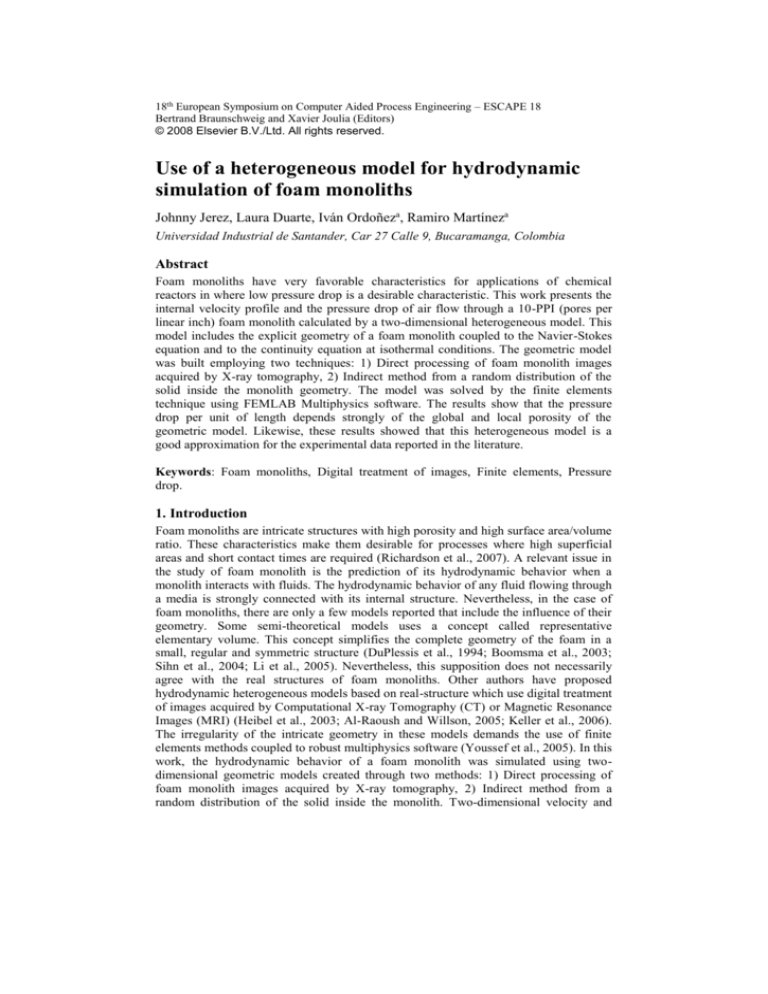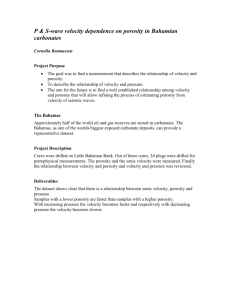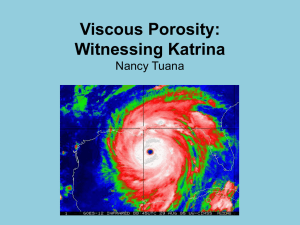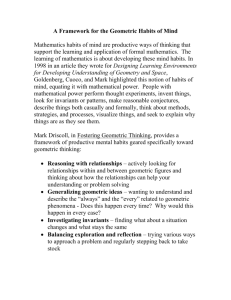
18th European Symposium on Computer Aided Process Engineering – ESCAPE 18
Bertrand Braunschweig and Xavier Joulia (Editors)
© 2008 Elsevier B.V./Ltd. All rights reserved.
Use of a heterogeneous model for hydrodynamic
simulation of foam monoliths
Johnny Jerez, Laura Duarte, Iván Ordoñeza, Ramiro Martíneza
Universidad Industrial de Santander, Car 27 Calle 9, Bucaramanga, Colombia
Abstract
Foam monoliths have very favorable characteristics for applications of chemical
reactors in where low pressure drop is a desirable characteristic. This work presents the
internal velocity profile and the pressure drop of air flow through a 10-PPI (pores per
linear inch) foam monolith calculated by a two-dimensional heterogeneous model. This
model includes the explicit geometry of a foam monolith coupled to the Navier-Stokes
equation and to the continuity equation at isothermal conditions. The geometric model
was built employing two techniques: 1) Direct processing of foam monolith images
acquired by X-ray tomography, 2) Indirect method from a random distribution of the
solid inside the monolith geometry. The model was solved by the finite elements
technique using FEMLAB Multiphysics software. The results show that the pressure
drop per unit of length depends strongly of the global and local porosity of the
geometric model. Likewise, these results showed that this heterogeneous model is a
good approximation for the experimental data reported in the literature.
Keywords: Foam monoliths, Digital treatment of images, Finite elements, Pressure
drop.
1. Introduction
Foam monoliths are intricate structures with high porosity and high surface area/volume
ratio. These characteristics make them desirable for processes where high superficial
areas and short contact times are required (Richardson et al., 2007). A relevant issue in
the study of foam monolith is the prediction of its hydrodynamic behavior when a
monolith interacts with fluids. The hydrodynamic behavior of any fluid flowing through
a media is strongly connected with its internal structure. Nevertheless, in the case of
foam monoliths, there are only a few models reported that include the influence of their
geometry. Some semi-theoretical models uses a concept called representative
elementary volume. This concept simplifies the complete geometry of the foam in a
small, regular and symmetric structure (DuPlessis et al., 1994; Boomsma et al., 2003;
Sihn et al., 2004; Li et al., 2005). Nevertheless, this supposition does not necessarily
agree with the real structures of foam monoliths. Other authors have proposed
hydrodynamic heterogeneous models based on real-structure which use digital treatment
of images acquired by Computational X-ray Tomography (CT) or Magnetic Resonance
Images (MRI) (Heibel et al., 2003; Al-Raoush and Willson, 2005; Keller et al., 2006).
The irregularity of the intricate geometry in these models demands the use of finite
elements methods coupled to robust multiphysics software (Youssef et al., 2005). In this
work, the hydrodynamic behavior of a foam monolith was simulated using twodimensional geometric models created through two methods: 1) Direct processing of
foam monolith images acquired by X-ray tomography, 2) Indirect method from a
random distribution of the solid inside the monolith. Two-dimensional velocity and
2
J. Jerez et al.
pressure distributions are reported as well as axial pressure drop profiles in function of
porosity and inlet velocity.
2. Methodology
2.1. Acquisition of real geometric information
For this study, a 10-PPI (pores per lineal inch) foam silica monolith was used. It was
manufactured by Vesuvius Hi-Tech Ceramics with 4.5 cm in diameter and 1.2 cm in
length. Real geometric information of a longitudinal section was obtained from this
monolith by CT technique which was carried out in a helicoidal Toshiba Aquilion32
Tomograph with resolution of 0.5 mm. In the tomography of Fig. 1a, the light zones
represent solid and the dark zones represent the empty space. Next, a digital processing
of the tomography was applied in three stages:
a). Segmentation: The original image is converted from the gray scale (256 colors) into
a black-and-white scale (binary). In this way, the solid portion (white) and the void
portion (black) look well differentiated. The segmentation is developed by setting a
threshold of color intensity. This threshold is calculated by built-in algorithms of image
processing toolbox of MATLAB software. The threshold value is a parameter which has
a stronger influence on the global porosity () of geometric model. In order of study the
heterogeneous model, three different degrees of segmentation were applied to obtain
global porosities of 75, 80 and 85%.
(a) X-ray tomography of 10 PPI-monolith
(b) FEMLAB geometric model ( = 85%)
Figure 1. Geometric model based on Direct method from X-Ray Tomography.
b). Building of foam geometry: Two strategies based on images acquired by CT
technique were utilized for the construction of the geometric model:
•
Direct method from X-Ray tomography: The outline of the binary image is
identified and a solid structure is created by a routine called flim2curve, a built-in
algorithm of FEMLAB. Fig. 1b shows the resultant solid structure.
•
Indirect method from random distribution of solids: The distribution of area of
the solid sections inside the monolith was obtained from the binary image (See Fig. 2a).
A computational routine was written in FEMLAB, which builds geometric models from
such distribution and allows to define the geometry as a function of the dimensions
(length and width monolith) and the desired porosity. The construction of the model
starts with a 100%-porosity structure (empty structure); next, circular solid sections are
added to this structure, in such a way that the porosity diminishes. The position of the
solid sections is set randomly. However the complete overlapping with other sections
already created is avoided. Once the desired porosity is reached, the procedure ends.
The randomness in this method causes that each generated model be unique. (See Fig.
2b).
Use of a heterogeneous model for hydrodynamic simulation of foam monoliths
c). Removal of small sections: Small sections of solid (< 0.2% area) diminish the
efficiency of the numerical method employed by FEMLAB. Previously, we found these
small sections do not have a significant effect on the global hydrodynamic behavior and
therefore this sections are digitally eliminated.
(a) Distribution of solids inside of the monolith.
(b) FEMLAB geometric model ( = 85%)
Figure 2. Geometric model based on Indirect method from distributions of solids.
2.2. Hydrodynamic model
The two-dimensional geometric model obtained above was coupled to momentum
balances. These balances are represented by the equation of Navier-Stokes along with
the continuity equation under isothermal conditions in steady-state (Equations 1 and 2).
u u u u p 0
(Eqn. 1)
u 0
(Eqn. 2)
T
Subject to the following boundary conditions:
2
Inlet velocity:
u 4umax x x
R
Outlet pressure:
p patm
Interphase gas-monolith:
u 0
(Eqn. 3)
(Eqn. 4)
(Eqn. 5)
In the equations above, is the density of the fluid, is the viscosity of the fluid, u is
the velocity vector, p is the pressure, umax is the maximum value of velocity of the inlet
velocity profile, x is the radial position, R is the monolith radius and patm is the
atmospheric pressure. In this work, the Navier Stokes equation is valid for a
compressible fluid because the our studied fluid (air) operates at isothermal conditions
and velocities much smaller than the sound velocity. The complex system differential
equations obtained was solved by the technique of the finite elements implemented in
FEMLAB Multiphysics software. The parameters of the numerical solver were: iterative
solver highly non lineal, max size element of 3x10 -6 mm2 and preconditioning spooles.
The model was simulated for different inlet air flow velocities (2, 4 and 6 m/s).
3
4
J. Jerez et al.
3. Results and discussion
Fig. 3 shows the internal velocity and pressure distributions for an inlet velocity of 6
m/s using two geometric models created by direct and indirect methods described in
section 2.1. Due to scale reasons, pressure values are reported considering zero as the
reference value for the atmospheric pressure. According to Fig. 3a, inside the monolith
structure, the formation of preferential flow paths is observed (light color) as well as no
flow zones (dark color). In both geometric models, the contractions presented the
maximum velocity and pressure values and there an important increment of the fluid
velocity and pressure drop occurs. It is observed that the structures obtained by the two
methods display a similar hydrodynamic behavior in quantitative terms; nevertheless,
the structure created from direct method presented smaller contractions which increased
flow resistance and promoted higher pressure drops.
Figure 3. Two-dimensional distributions of velocity and pressure for structures
obtained by (a) Direct method from X-ray tomography and (b) Indirect method using
distribution of solids. (Inlet velocity = 6 m/s, = 85%).
Semi-empirical models such as the Ergun equation, assume that the porosity is constant
along the porous media and the resultant axial profiles are usually lineal with respect to
the length. In this work, the axial pressure profiles were calculated from the twodimensional distribution pressure showed in Fig. 3b. To do this, the mean radial
pressure was measured in 10 different points, all of them equally spaced throughout
each one of the structures. Fig. 4a shows a staggered behavior of the axial profiles, that
is to say, zones where the pressure remains mainly constant as well as zones where a
fast pressure drop is produced. When the value of local porosity of each zone was
evaluated (See Fig. 4b), the zones of strong pressure drop correspond to local porosity
decreasing and zones of weak pressure drop correspond to local porosity increasing.
Altough both geometric models have equal global porosity (85%), the axial pressure
profile is very influenced by the local porosity distribution of each geometric model. In
consequence, the global pressure drop was influenced too. The staggered behavior of
the axial profiles was more prominent on models from X-Ray Tomography because the
local porosity profile fluctuates between higher and lower values. The local porosity is a
non-controllable variable by the geometric foam building method. It can set the
magnitude order of the local porosity from global porosity but not its two-dimensional
distribution. Therefore, the influence of local porosity was studied repeating the
methodology described in the section 2 for three different CT images of real foam
monolith. The influence of the local porosity distribution on pressure drop was very
Use of a heterogeneous model for hydrodynamic simulation of foam monoliths
similar to the results showed in Fig. 3 and 4. It means that the local porosity is a
variable intrinsic of each CT image and geometric foam building method. The
differences in pressure drop among the results showed previously and the new models
were 11% on average. It means that predictions of heterogeneous models proposed here
offers consistent results and do not depend on image selected in strong way while the
global porosity be the same for both geometric models.
Figure 4a. Axial pressure profile obtained by
Figure 4b. Local porosity of geometrical model
direct and indirect methods. (Inlet velocity = 6
built by direct and indirect methods. ( = 85%)
m/s, = 85%).
3.1. Validation
The global pressure drop per length was validated at the same experimental conditions
reported by Richardson et al. (2003) for a 10 PPI-monolith of alumina with a porosity
() of 87.8% . Fig. 5a shows that global pressure drop is strongly influenced by the
global porosity of the geometric model.
(a) Different porosities with geometric model
(b) Different geometric models (porosity =
from X-Ray tomography.
87.8%)
Figure 5. Comparison of pressure drop per length against Richardson et al. (2003).
The pressure drop calculated by our model is close to experimental value when the
porosity reported for Richardson et al. (2003) is reached. Fig. 5b shows that the
predictions of both geometric models are very similar to experimental data, specially at
5
6
J. Jerez et al.
low velocities (< 4 m/s). In general, pressure drop predictions of any geometric model
offers a acceptable level of error.
4. Conclusions
The two-dimensional heterogeneous model developed here can obtain good
approximations to real hydrodynamic behavior of 10 PPI-foam monoliths. The models
can predict the low global pressure drop presented in foam monoliths using geometric
information only. Additionally, reveals locations of maximum and minimum of velocity
and pressure which can be useful for design proposes. The global pressure drop and
axial pressure profile are strongly influenced by local and global porosity of geometric
model. When local porosity varies along the monolith then the heterogeneous model
predicts fluctuations between strong and weak local pressure drops which finally
influences on global pressure drop.
Acknowledgments
The authors are grateful with COLCIENCIAS/UIS (Colombia) scholarship for financial
support and ESCANOGRAFIA S.A. (Carlos Ardila Lulle Clinic) for technical
cooperation.
References
Al-Raoush, R. I. and Willson, C. S., 2005, Extraction of physically realistic pore network
properties from three-dimensional synchrotron X-ray microtomography images of
unconsolidated porous media systems, Journal of Hydrology, 300, p. 44–64.
Boomsma K., Poulikakos D., Ventikos Y., 2003, Simulations of flow through open cell metal
foams using an idealizad periodic cell structure, International Journal Heat Fluid Flow, 24,
825–834.
Du Plessis P., Montillet A., et al., 1994, Pressure drop prediction for flow through high porosity
metallic foams, Chemical Engineering Science, 49, 3545-3553.
García-González, R., Monnereau, C., et al., 1999, Conductivity of real foams, Colloids and
Surfaces A: Physicochemical and Engineering Aspects, 151, p. 497–503.
Heibel, A. K., Vergeldt, F. J., et al., 2003, Gas and liquid distribution in the monolith film flow
reactor, AIChE Journal, 49, p. 3007-3017.
Keller A., Auset M., 2006, A review of visualization techniques of biocolloid transport processes
at the pore scale under saturated and unsaturated conditions, Advances in Water Resources,
30, p. 1392-1407.
Richardson J. T., Peng Y., Remue D., 2003, Properties of ceramic foam catalyst supports:
pressure drop, Applied Catalysis A: General, 250, 319-32.
Sihn S., Roy A.K., 2004, Modeling and prediction of bulk properties of open-cell carbon foam,
Journal of Mechanics and Physics of Solids, 52, 167–19.
Youssef, S., Maire, E., et al., 2005, Finite element modeling of the actual structure of cellular
materials determined by X-ray tomography, Acta Materialia, 53, p. 719–730.








